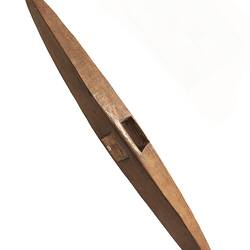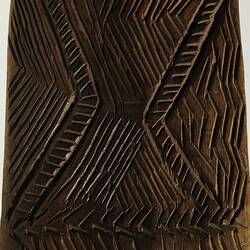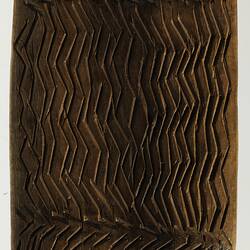Summary
Long elliptical parrying shields such as this were used in close combat, in defence against the heavy blows of clubs and similar weapons. In the Lower Murray region, they were triangular in cross-section and cut from a solid piece of hardwood such as Australian cherry wood, a timber considered by the Ngarrindjeri to have special properties. According to the Ngarrindjeri living in the area of Lake Alexandrina, if the Australian cherry wood was burnt, then all the fish would leave the Coorong inlet, a significant waterway on the coast of South Australia.
This shield features geometric patterning which is a common stylistic feature of designs from south-eastern Australia. Other common aspects of south-eastern designs can be seen in the use of free-form flowing curves and designs based on lines. Designs used by south-eastern Aboriginal groups have multilayered meanings and hold detailed information about the makers identity, clan grouping, Country, totems, stories and ceremony.
Shield designs are visually arresting, the elaborately incised and ochre designs create optical illusions during battle, a quality enhanced by the dexterity of the warriors. Ochres were sometimes used to make the incised designs stand out boldly.
Stone tools were used for the initial shaping of parrying shields. Once shaped and while the wood was still fresh, designs would be carved into the anterior, and occasionally posterior, surface, using engraving tools such as flint, volcanic glass, stone and mussel shells. Different species of trees needed to be incised with different tools, but in the Lower Murray region, possum-tooth engravers tended to be highly favoured.
Physical Description
An elliptical shaped shield with pointed ends and triangular cross section. Handle is carved from solid and does not protrude. Anterior surface is decorated with concentric geometric lines. Posterior surface is undecorated.
Significance
This shield was made by a Ngarrindjeri man sometime around 1850. The Ngarrindjeri peoples are the traditional owners of the lower Murray River, western Fleurieu Peninsula and the Coorong area of southern, central Australia. The Ngarrindjeri peoples have occupied these areas for thousands of generations and continue to work, live and practice their culture on their traditional lands today. Today, many thousands of people identify as Ngarrindjeri, with the majority living in the Lower Murray and Coorong regions of South Australia.
A resurgence of shield making by Ngarrindjeri carvers began in 1992 with Ngarrindjeri man Paul Kropinyeri's bark shields included in the Nyoongah Nunga Yura Koorie exhibition at Tandanya National Aboriginal Cultural Institute in Adelaide. It is important to note that while the shields of this generation utilise many of the same skills, techniques and materials as the shield makers of the 1930s, cultural shifts and adaptations have led to changes in manufacture. For example, it is no longer considered respectful to use carved ngatji (totem) designs on shields because, as weapons of war that are now not used or manufactured for that purpose, the sacred designs the shields once featured are no longer appropriate to share with the wider audience now looking at Ngarrindjeri shields.
This Ngarrindjeri shield was one of the large amounts of material culture from south-eastern Australia that was taken overseas in the 19th and 20th centuries. It came into the Museum collection in 1995 following a donation by an international collector.
More Information
-
Object/Medium
Shield
-
Maker
-
Cultural Groups
-
Locality
-
Date Produced
-
Collector
-
Date Collected
-
Object Measurements
1010 mm (Length), 150 mm (Width), 120 mm (Height)
-
Classification
-
Date Made
-
Maker
-
Clan/Language Group
-
Place Made
-
Indigenous Region
-
Collection Names
-
Type of item
-
Discipline
-
Category
-
Collecting Areas











